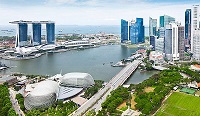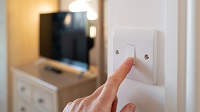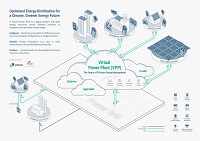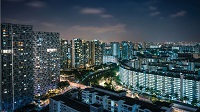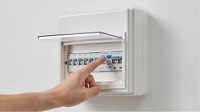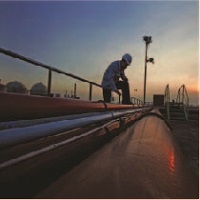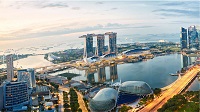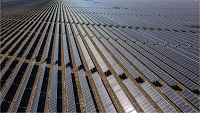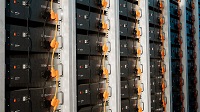A Singapore Government Agency WebsiteHow to identify
Official website links end with .gov.sg
Government agencies communicate via .gov.sg websites
(e.g. go.gov.sg/open).Trusted websites
Secure websites use HTTPS
Look for a lock ( )or https:// as an added precaution. Share sensitive information only on official, secure websites.
We refer to the article "Solar panels yet to shine" (ST Life, May 24) by Natasha Zachariah.
The Energy Market Authority (EMA) fully supports the use of solar energy, and we are glad to see a growing interest among homeowners and developers to install solar panels on their rooftops. Solar energy is clean and has no emissions. It improves Singapore's energy security as it does not require any fuel imports. Solar energy also helps to reduce costs for consumers by lowering their demand for electricity from the grid.
At the same time, it is important to recognise the constraints and trade-offs of solar energy. For example, it is intermittent in nature and fluctuates based on weather conditions, cloud cover and shadows. Competing uses for rooftop space could affect the amount of solar energy deployed. In addition, we should exercise caution before adopting practices of countries like Germany and Spain, which rely on subsidies to encourage adoption of renewable energy. This has distorted their energy markets and increased the costs for consumers. These countries have found it financially unsustainable to continue with their subsidies, especially when the main beneficiaries are higher-income consumers who install solar panels on their properties.
It is also important for discussions on solar energy to be based on accurate facts. In the article, Dr Thomas Reindl from the Solar Energy Research Institute of Singapore said a grid utilisation charge is levied on "green" electricity fed into the grid. This is incorrect. We do not levy any grid charges on solar owners who sell into the grid. Similar to other generation sources, solar producers are paid the energy cost of any electricity that they export into the grid. This provides a level playing field for all generation sources.
Over the past few years, EMA has taken steps to facilitate the deployment of solar energy in Singapore. Our aim is to allow consumers to use as much solar as possible, when they decide that the technology has become commercially viable. EMA has conducted a review in consultation with the solar industry and other stakeholders to enhance our regulatory framework and make it easier for consumers to use solar energy. The findings and recommendations will be released in June 2014.
Eng Zhen-Hui
Director, Policy Department
Energy Market Authority
Solar panels yet to shine
Tedious research and high cost are putting home owners off solar panels Solar panels ought to be all the rage in sunny Singapore.
After all, there is no shortage of sunlight and the savings on electricity bill are sweet. Still, architects and building industry players say more needs to be done to entice local home owners to install them.
Mr Lim Hong Kian, director of designshop.architects, has incorporated solar panels into six houses over the last four years - compared to seven homes without them in the same time period.
"There is that initial capital outlay that puts off many home owners, even if you can make back the cost in a few years," says Mr Lim, 41.
But for those who want to do it for environmental reasons, he adds: "It's not a matter of budget anymore as it becomes really about conservation."
Dr Thomas Reindl, deputy chief executive officer of the Solar Energy Research Institute of Singapore, says there are three reasons most private home owners are not on board with getting a solar panel system: a lack of knowledge of how the panels would work on their buildings and within the electricity grid; uncertainty about what goes into putting a solar panel system in their house; and the grid utilisation charge, which is levied on every "green" electricity which is fed into the public grid.
He suggests looking at Germany as a good model of private homes adopting solar panels, as ordinary home owners get paid for the renewable electricity they generate.
"Germany has the largest installed capacity of solar power with 35GWp in total. Around half of that is private residential buildings. The main driver was that people not only enjoy 'green energy' but also make a reasonable return on investment over time. This is possible in Singapore too."
Aside from just private homes, Mr Lee Boon Woei, director of DP Sustainable Design, a subsidiary of DP Architects, says even as condominium developers have become more aware of the green cause in the last five years, it has "yet to see solar panels gain widespread usage".
Mr Lee, 44, says: "The technology of solar panels is still evolving, even though it is quite mature now, so it could be more efficient in the coming years. Developers might not want to lose out on returns so they opt to wait and see what's going to happen next."
The firm did a private residential home in Boon Teck Road in 2011, which featured solar panels. The three-storey inter-terrace house was the first private home to be given a Green Mark Platinum Award from the Building and Construction Authority.
But Mr Lee notes that solar hot-water systems, which heat up water for domestic usage, is more popular among residential developers. They differ from solar panels, or photovoltaic (PV) panels, which harvest solar energy and convert it to alternating current for electrical appliances. Solar hot- water systems absorb energy from the sun to heat water.
Last week, The Straits Times reported that more Singaporeans are using solar power to cut their bills and companies here which sell these panels are seeing more business. But the report added that it was still mainly commercial and industrial properties acquiring and using these panels.
Last November, supermarket giant Sheng Siong said it will kit out its distribution centre in Mandai with panels which will cover 11,000 sq m of the rooftop.
The Singapore Sports Hub, which is due to host its first events next month, has a 7,000 sq m rooftop installation, which will not only produce solar energy, but also act as a sunshade - two examples out of many others taking similar steps.
In comparison, Singapore-based Phoenix Solar, a company which sells solar panels, says in the eight years it has been around, it has installed its products in only about 30 homes.
But sustainability consultant Deepshi Bhogal at Pomeroy Studio says "solar technology is increasingly becoming an accepted part of a building's 'kit of parts'".
Her firm, Pomeroy Studio, is designing a 480 sq m house in Novena - designed by its United Kingdom-registered architect Jason Pomeroy - that will be completed next year and will have a PV output of about 18,360kWh a year. This will be enough to power a five-person household, with energy- efficient LED lighting, ceiling fans, receptacle and pump loads, which is estimated to use 8,130kWh a year. The balance can support the occasional use of an energy-efficient air-conditioning system.
Mr Pomeroy has also designed the first zero- carbon house in Asia.
Ms Bhogal adds: "Solar technology has come a long way from the polycrystalline grids one normally associates with solar panels. Thin membranes can be applied on vertical glass surfaces that can act as shading or a glare control device, as well as a source of energy."
One developer taking on the green cause in Singapore is City Developments Limited (CDL), which is building Haus @ Serangoon Garden. It is the first landed housing development in Singapore - there are 97 terrace houses - to have a 1 kilowatt-peak PV system. It is also the first landed housing development here to achieve the Building and Construction Authority's Green Mark Platinum Award.
The property, which was launched in July 2012, was fully sold by March the following year. At the launch, prices started from $2.4 million for a 1,615 sq ft land intermediate terrace unit and from $2.8 million for a 2,284 sq ft land corner terrace.
Mr Allen Ang, senior vice-president for projects at CDL, says home owners who bought units were drawn to the property's location and unique design, and saw the solar panels as an added bonus to help conserve energy.
"We invested 4 per cent of the total construction cost for Haus @ Serangoon Garden in green innovations such as the solar panels," says Mr Ang. "But owners of each house can enjoy up to an estimated 40 per cent energy savings a month, depending on their individual lifestyle and usage pattern."
But while these panels are all the rage now in the era of green talk, DP Sustainable Design's Mr Lee cautions that how a building sustains the environment should be considered as a whole. "If one installs solar panels but have a building that wastes energy, the overall effect is still not ideal."
His firm recommends designing with computer simulations at the beginning of a project to make the building more energy-efficient from the start, rather than add green features later.
Soberingly, as long as solar panels remain more within the realm of cutting-edge technology than user-friendly standard equipment, however, the odds are stacked against it becoming more popular here.
Home owner Sylvia Tan, 67, who lives on a compound which has two attached houses in Bukit Timah, is put off by the amount of research she has to do to get a solar panel system installed.
The cookbook author and freelance writer is a "fierce recycler" and takes conservation seriously. She had a solar hot-water system installed in the 1990s, when few people were doing it then.
While she has the roof space for such panels, she says: "Having solar panels is a good idea because we can make use of our abundant sunlight. But there're so many steps from researching which panels are right to installing the system, which puts me off getting one.
"If it gets easier to acquire one, I will get it."
Tapping natural elements
Besides installing solar panels as part of his eco-friendly theme, architect Randy Chan has an open-air area (above) on the second floor that lets in the breeze. An exposed brick wall and pipes, also on the second floor, give the terrace house a New York-loft feel.
An open-concept house with no windows - nothing in front, in fact - seems unfinished. But isn't. It has solar panels too. Not that it needs them much.
When Urban Redevelopment Authority (URA) officials were looking over plans for architect Randy Chan's home, a 31/2-storey intermediate terrace house off Pasir Panjang Road, they wondered if something was missing. Unlike regular houses which have their facades walled up, the house is open, such that you can look through the front and see the various levels of it inside.
Mr Chan, 43, principal at architecture firm Zarch Collaboratives, says: "The URA thought I had made an incomplete submission because it wasn't able to physically see how the house looks and its technicalities to understand its sustainable features.
"A house without windows is a concept in itself, so part of the design was keeping the openings as big as I can afford so wind can easily pass through. I could keep the house this open because I'm not blocked by other houses. A lot of people are concerned about security, but I have good neighbours and the house is off the main road, so it's quiet too."
Beyond the astro-turfed gate - the grilles are covered in the furry synthetic grass - his 3,700 sq ft abode is the model house for green living. Completed in 2012, the house won the Green Mark Platinum Award from the Building and Construction Authority on Thursday night. The award is given to owners or developers of environmentally friendly buildings, with points for green features.
One of the green features is a dug-out on the first floor that acts as an airwell to let the natural breeze flow through the house. In line with his eco-friendly theme, Mr Chan has also used recycled timber throughout the house - for the staircase, which is encased by steel rods, and the doors.
The creme de la creme is a 12m-long bio pool on the second storey. The pool, which does not have chlorine, gets filtered water from a pond which has plants and fishes in it. Evaporation from the water cools this space that also houses the kitchen and dining area in a reversal of typical residential layouts, which have these spaces on the ground floor.
Mr Chan, who lives with his wife, says: "It really feels like I'm living in the outdoors. My fish started disappearing from the pond when I first put them in and I realised that it was the kingfishers from the nearby trees that were stealing them. We also get a lot of parrots and squirrels coming here."
On the upper levels, Mr Chan, who won a President's Design Award for Design of the Year in 2012 for his work with Ms Grace Tan, of multi- disciplinary practice kwodrent, has put in eaves to frame the house and to keep out the rain. There is also a vertical garden on the top floor, which offers a view of the houses in that Kent Ridge Hill area.
The flat roof has 20 solar panels, which cost him about $19,000, and a solar water heater, where water for the house is heated by sunlight.
Visitors will notice that he hardly switches on the fan, instead relying on the breeze to ventilate the house. But with the haze season due soon, he says: "The back-up plan is to install roller shutters. I don't want to do it, but I will if I have to."
He agrees that many people would baulk at the idea of living in his experimental house. It cost him about $500,000 to demolish the old single-storey house and rebuild it as it is now.
"Everyone goes on about sustainability, but what does it really mean? A lot of architectural clients ask for green features in their home, but then turn on the air-conditioning all the time. It's a paradox," he says. "It's part of my office's ethos to be sustainable and I want to walk the talk. When I could afford to get my own place, I wanted the design of my house to be convergent with my beliefs."
Natasha Ann Zachariah
